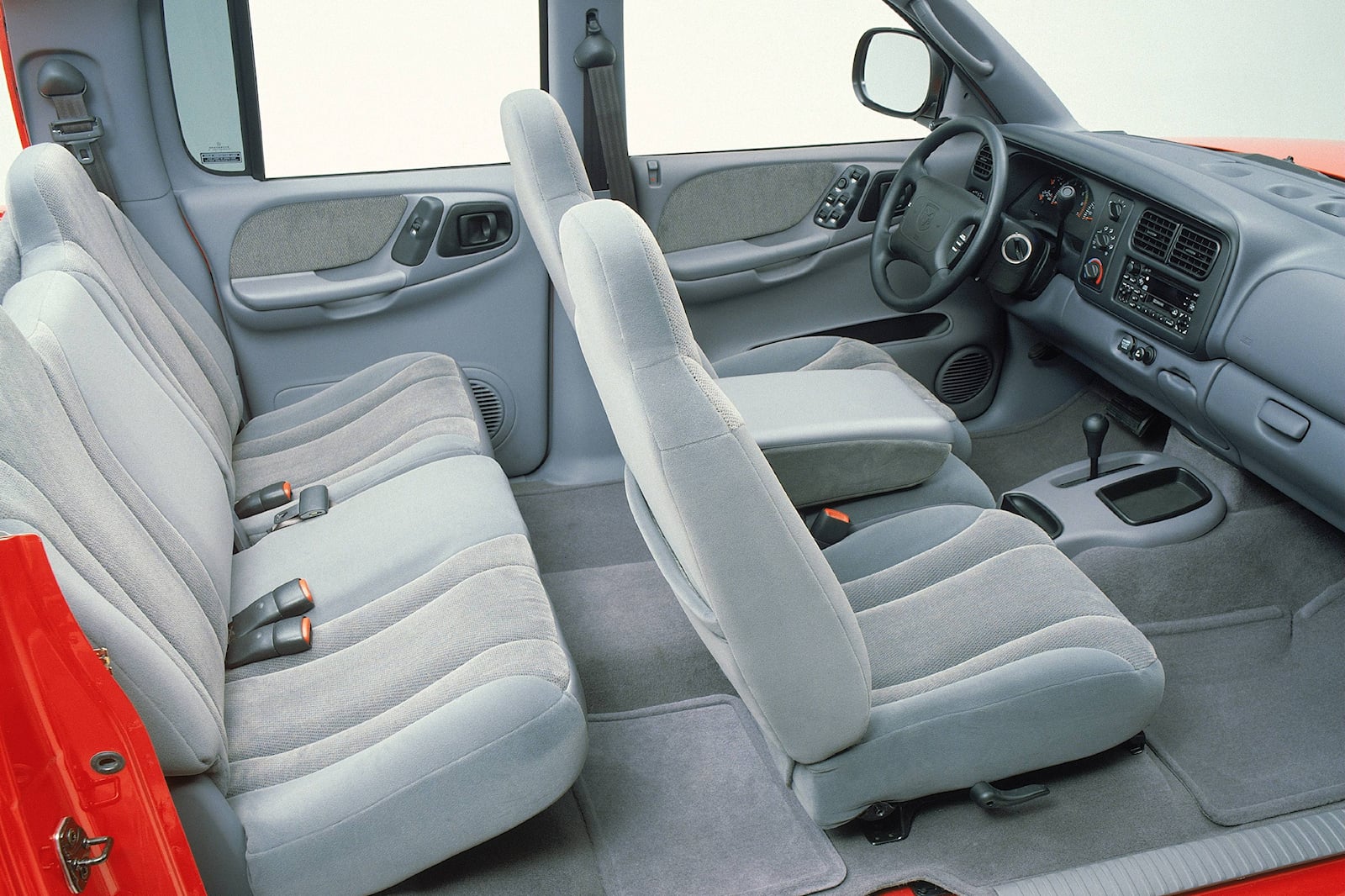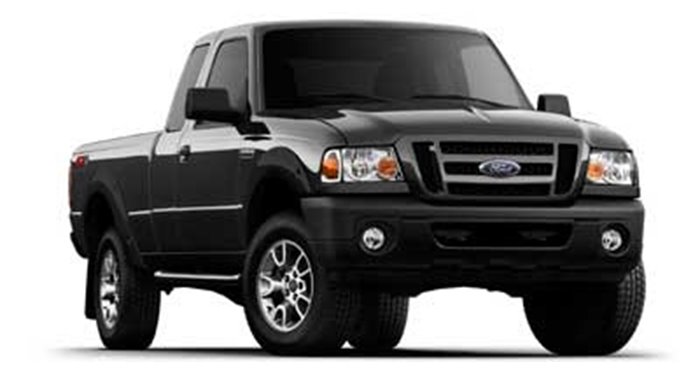For the second-generation Dodge Dakota, three variations of the Magnum engine were introduced. This includes one downsized V6 and two V8 options. All options feature an OHV pushrod design and are essentially modernized Chrysler LA engines which were first introduced in 1964. The LA-derived Magnum 5.2 and 5.9 V8 found in early examples of the second-generation Dodge Dakota are criticized for their low power output in relation to their displacement, and their gas consumption. However, users note that they can be more reliable than Ford's competing Triton engine family sold during the same era. The more dependable variation of the two V8s is the smaller 5.2-liter unit.
The most common mechanical problem you can expect to experience with both V8 Dodge Dakota options is an intake-manifold gasket leak. The gasket at fault is the one located between the two separate pieces of the two-piece intake manifold - the cast aluminum top part and its stamped steel bottom plate. This is a common failure point that will leak air and result in the engine losing vacuum and perform poorly. It is barely noticeable at first, but it will eventually cause blocked catalytic converter problems for the Dodge Dakota. Once this happens, there will be a dramatic decline in engine performance. Once you start to notice symptoms such as pinging, poor running, and increased oil consumption, and issues associated with high oil consumption, such as fouled spark plugs and oxygen/O2 sensor problems for the Dodge Dakota, it is advised that you replace the plenum gaskets. Blocked cats will also bring up the P0151, P0420, P0422, P0426, P0430, P0432, or P1196 fault codes. P1301 will indicate that a spark plug on bank one has failed and could be one of the fault codes you see. Failure to resolve these issues will lead to ruined catalytic converters and several other expenses. Replacing it with an OEM gasket will lead to the problem repeating, so it is advised that you consider the various after-market fixes available. This includes fitting a modified aftermarket one-piece plenum plate or a redesigned aftermarket intake manifold.
Blocked catalytic converters will also cause a pressure buildup that can speed up the 5.9's tendency to crack its cylinder heads despite them being made from cast iron. The heads on the 5.9-liter units are considered to be weak and some other factors, such as blocked catalytic converters, can result in cracking. The heads usually crack between the valve seats. Most of the cracks are usually very small and may not stop the engine from running, but if you experience coolant mixing with oil, which will result in the P1281 fault code, overheating, or misfires, the cracks have grown to be too big and must be resolved. P1792 will trigger if your engine coolant temperature sensor is acting up. If your powertrain is misfiring, you'll see the P0300, P0301, P0302, P0303, P0304, P0305, P0306, or P0307 fault codes with the last number indicating which bank is at fault. P1309 means that the misfiring detection system is inoperable. Small cracks can grow in size, which is not a risk that should be taken. The only means of resolving this problem is by fitting upgraded aftermarket cylinder heads, which can be a costly job.
Timing chains are not particularly troublesome, but in the second-generation Dodge Dakota's Magnum engines, they do not have an unlimited lifespan and may elongate by 100,000 miles, which will lead to rattling and require replacement. Deferring your oil changes and general neglect will result in these issues occurring sooner but we recommend replacement by 150,000 miles, even if they still seem to be in a solid condition. An elongated chain can jump teeth and cause significant engine damage through piston-to-valve contact. Most owners opt to upgrade their chain to a twin-roller, dual-row timing kit for a longer service life.
Cam-position sensors are a point of weakness in the Magnum 5.2-liter V8 and can result in rough running and poor performance. This engine also struggles with broken exhaust-manifold bolts, which will result in a ticking noise emitted from under the hood as well as the smell of raw exhaust gasses. Both the bolts and manifold gaskets will have to be replaced when this happens.
The smaller 3.9-liter V6 has a reputation of being the most reliable variation of the Magnum engine family and doesn't suffer from cracked cylinder heads or failed cam-position sensors. The timing chain also draws fewer complaints, likely due to it being under less strain and resistance due to the fewer moving parts, however, it is advised that you still keep an ear out for rattles and consider replacing the part at 150,000-mile intervals, regardless. A leaking intake manifold is still an issue on the V6, together with manifold absolute pressure (MAP) sensor failure that happens occasionally. This fault might trigger the P0108 or P0129 fault code.
Generally speaking, the Magnum engine family used in the second-generation Dodge Dakota appears to vary across users. Intake-manifold issues appear to be the most common flaw so this part should be upgraded regardless of condition. Timing chains are consumables and should be either replaced or upgraded at 150,000-mile intervals. Cylinder heads on the 5.9-liter unit are unlikely to cause trouble if your catalytic converter and cooling systems are sound.
If you come across a Magnum-powered second-generation Dodge Dakota that has been meticulously maintained, there is no reason why the engine shouldn't surpass 300,000-350,000 miles. Regardless, you may still come across some of these problems simply due to the age of the compact truck.
Mileage: Bad plenum gaskets are prone to leaks at any mileage. Cylinder heads crack are caused by catalytic converter problems or overheating rather than mileage covered. Timing chains are likely to last from 100,000 to 150,000 miles. Cam-position sensors may fail on the 5.2-liter when they get dirty or clogged. Catalytic converters will start to get clogged at 150,000 miles. This will happen sooner if you neglect the intake-manifold leak.
Cost: A plenum-gasket leak repair kit is available for about $185 excluding the cost of fitment. This replaces the plenum plate with a one-piece aluminum plate. A single-piece aftermarket intake manifold will be no less than $700 before installation costs. The upgraded dual-row timing-chain kit, and timing-cover gasket set will cost around $100, excluding installation. The 5.2-liter OHV's cam-position sensor costs about $30 before fitment. 46-state legal catalytic converters costs will range between $230 and $350 before fitment. 50-state legal cats are at least between $360 to $860. Cracked cylinder heads can be welded or repaired. The cost varies depending on how severe the damage is. New cylinder heads are scarcely available which means you may have to consider used parts which vary in price. Aftermarket cylinder heads are usually priced at $2,000 before the cost of fitment.
How to spot: Leaky plenum/intake manifold gaskets will cause excessive oil consumption, dirty spark plugs and oxygen sensors, a rough engine idle, misfiring, pinging, bad gas economy, and a reduction in power. It is advised that you open the throttle body visually inspectit for oil or sludge points which can point to a bad plenum gasket. Also consider removing the positive crankcase ventilation (PCV) valve to confirm that there is air pressure. Air should be coming out but if there is vacuum, it means that the plenum gasket is leaking. Cracked cylinder heads will result in overheating, misfires, oil and coolant leaks, milky oil due to coolant contamination, or oily coolant due to oil contamination. You should conduct a cylinder leak down test to confirm a cracked head. An elongated timing chain will likely commonly cause misfires, but may also rattle or cause rough idling or reduced power. Camshaft-position sensor failures cause hard starting problems, rough running, misfires, poor performance, and an illuminated Check Engine light. You'll also notice the P0016, P0340, P0344, P0345, P1341, P1391, or P1398 fault codes. Variable camshaft timing solenoid failure will be signaled by the P1388 fault code.






 Acura
Acura
 Alfa Romeo
Alfa Romeo
 Aston Martin
Aston Martin
 Audi
Audi
 Automobili Pininfarina
Automobili Pininfarina
 Bentley
Bentley
 BMW
BMW
 Bollinger
Bollinger
 BrightDrop
BrightDrop
 Bugatti
Bugatti
 Buick
Buick
 Cadillac
Cadillac
 Caterham
Caterham
 Chevrolet
Chevrolet
 Chrysler
Chrysler
 Dodge
Dodge
 Ferrari
Ferrari
 Fiat
Fiat
 Fisker
Fisker
 Ford
Ford
 Genesis
Genesis
 GMC
GMC
 Gordon Murray Automotive
Gordon Murray Automotive
 Hennessey
Hennessey
 Honda
Honda
 Hyundai
Hyundai
 Ineos Automotive
Ineos Automotive
 Infiniti
Infiniti
 Jaguar
Jaguar
 Jeep
Jeep
 Karma
Karma
 Kia
Kia
 Koenigsegg
Koenigsegg
 Lamborghini
Lamborghini
 Land Rover
Land Rover
 Lexus
Lexus
 Lincoln
Lincoln
 Lordstown
Lordstown
 Lotus
Lotus
 Lucid Motors
Lucid Motors
 Maserati
Maserati
 Mazda
Mazda
 McLaren
McLaren
 Mercedes-Benz
Mercedes-Benz
 Mini
Mini
 Mitsubishi
Mitsubishi
 Nissan
Nissan
 Pagani
Pagani
 Polestar
Polestar
 Porsche
Porsche
 Ram
Ram
 Rimac
Rimac
 Rivian
Rivian
 Rolls-Royce
Rolls-Royce
 Spyker
Spyker
 Subaru
Subaru
 Tesla
Tesla
 Toyota
Toyota
 VinFast
VinFast
 Volkswagen
Volkswagen
 Volvo
Volvo